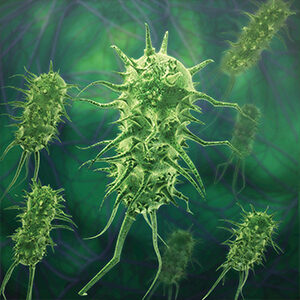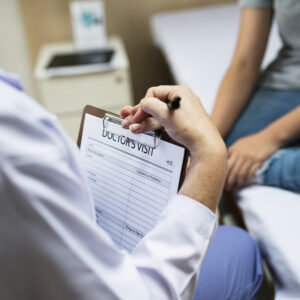Overview
Respiratory syncytial (sin-SISH-uhl) virus (RSV) can affect people of all ages.
Basics
What is RSV?
Respiratory syncytial (sin-SISH-uhl) virus (RSV) is a respiratory virus that can affect people of all ages. While most people experience symptoms similar to a mild case of the common cold, RSV can cause serious symptoms in some individuals. According to the CDC, RSV is the most common cause of bronchiolitis (inflammation of the small airways in the lung) and pneumonia (infection of the lungs) in children under age 1. On average in the United States, RSV leads to over 50,000 hospitalizations in children younger than 5 years old and 60,000 – 120,000 older adults each year. RSV typically begins circulating in the fall and peaks in winter, although this varies from year to year.
Symptoms
Symptoms of RSV are similar to other respiratory infections and usually begin with four to six days after exposure. Symptoms may include coughing, sneezing, runny nose, fever, wheezing and decreased appetite. These symptoms typically do not occur at once, instead appearing in stages.
In very young infants, irritability, decreased activity, and breathing difficulties may be the only symptoms of infection.
Care
RSV infections typically clear up on their own within one to two weeks. While there is no treatment for RSV, you can take steps to reduce discomfort from symptoms:
- Use over-the-counter medications such as ibuprofen or acetaminophen to reduce fever and pain (no aspirin for children)
- Prevent dehydration by drinking plenty of fluids
- Talk to your child’s healthcare provider before giving your child nonprescription cold medicines, as some have ingredients that are not good for kids
Complications
Complications from severe RSV infections may include bronchiolitis, an inflammation of the small airways in the lung, and pneumonia, a lung infection. Usually, healthy adults and infants with RSV do not need to be hospitalized, but some individuals, including older adults and infants younger than 6 months, may need to go the hospital if they are dehydrated or having trouble breathing. In these cases, they may need intravenous (IV) fluids, intubation or mechanical ventilation to help them breathe. These individuals usually recover with supportive care and may go home within a few days Call your healthcare provider if you are experiencing worsening symptoms or if you are unable to drink enough fluids. Call 9-1-1 if you are having difficulty breathing.
Transmission
RSV can be spread when an infected person coughs or sneezes. Coughing and sneezing send virus-containing droplets into the air, where they can infect a person who inhales the droplets.
Infection can also result from direct and indirect contact with nasal or oral secretions from infected persons. Direct contact with the virus can occur through close physical contact, such as kissing the face of an individual with RSV. Indirect contact can occur by touching a surface contaminated with viral particles, such as a doorknob. Direct and indirect transmission of the virus usually happens when people touch a contaminated surface and then touch their eyes, mouth, or nose. RSV can live on hard surfaces for many hours and on soft surfaces for shorter amounts of time.
A person with RSV infection is usually contagious for three to eight days, but they might be infectious a day or two before symptoms start. However, some infants and people with weakened immune systems can be contagious for as long as four weeks.
Risk Factors
Children and older adults are more at risk for severe illness and hospitalization associated with RSV.
Infants and Children
Almost all children are infected with RSV by their second birthday. RSV typically causes mild, cold-like sickness, but it can also become bronchiolitis (inflammation of the small airways to the lung) or pneumonia (a lung infection).
Annually, about 58,000 to 80,000 children younger than 5 years develop severe disease resulting in hospitalization in the United States, and about one to two out of every 100 children younger than 6 months will need to be hospitalized.
Who is at risk?
Children and infants most at risk for severe infection include the following:
- Premature infants
- Very young infants—particularly 6 months and younger
- Children younger than 2 years old with chronic lung disease or congenital heart disease
- Children with a weakened immune system
- Children with neuromuscular disorders, including those who have difficulty swallowing or clearing mucus secretions
Learn more about severe RSV infection in children.
Older Adults
Some adults are at greater risk for severe RSV infection than others. CDC estimates show that each year, 60,000-120,000 older adults in the United States are hospitalized and 6,000-10,000 die from RSV. While most adults will only experience cold-like symptoms, some adults may develop a lung infection or pneumonia. This can lead to worsening of other preexisting conditions such as asthma, chronic obstructive pulmonary disease (COPD) and congestive heart failure (CHF). In cases where RSV progresses, hospitalization may be necessary.
Who is at risk?
Adults at greatest risk for severe infection include the following:
- Older adults —especially those over age 65
- Adults with chronic heart or lung disease
- Adults with weakened immune systems
Older adults are more likely to get very sick from RSV because immune systems tend to become weaker as we age.
Diagnosis
RSV is diagnosed through several methods; the most common is to test with a PCR or antigen test administered by a healthcare provider. Antigen tests are more likely to be used for children while a PCR test, which is more sensitive, is indicated for adults and older youth, who typically have a lower viral load than children.
Treatment
There are no specific treatments for RSV.
Prevention
Vaccines
Two RSV vaccines have been approved by the Food and Drug Administration (FDA) and reviewed by the Advisory Committee on Immunization Practices (ACIP). These are Arexvy or Abrysvo.
- All people ages 60 years and older may receive a dose of either vaccine.
- Abrysvo has also been approved by the FDA to be given to pregnant people at 32 to 36 weeks of pregnancy to help protect babies from RSV from birth to 6 months.
Monoclonal Antibody Products
For children ages 2 years and younger, other prevention options are available: these are nirsevimab (Beyfortus) and palivizumab (Synagis).
- The CDC recommends nirsevimab, a monoclonal antibody injection, for infants younger than 8 months born during or entering their first RSV season and children ages 8 to 19 months who are at increased risk for severe RSV disease and entering their second RSV season.
- Palivizumab (pah-lih-VIH-zu-mahb) is available for the prevention of severe RSV illness in infants and children who are at high risk for complications. This drug does not cure or treat children with severe RSV infections, and it does not prevent infection with RSV. Parents of children who are at high risk for severe infection with RSV should talk to their healthcare provider about using palivizumab as a preventive measure.
Learn More
- Children’s Hospital of Philadelphia RSV and Babies — A Bit of Hope
- Centers for Disease Control and Prevention For Children 19 months and Younger
Pediatrician Discusses RSV Cases
Video courtesy of the American Academy of Pediatrics.
What is RSV?
Recommendations
The steps you can take to prevent the spread of RSV are similar to the precautions you would take for other respiratory illnesses. People who have cold-like symptoms should:
- Cover their coughs and sneezes
- Wash their hands often with soap and water for at least 20 seconds
- Avoid close contact with others such as kissing, shaking hands and sharing dishware and utensils
- Clean frequently touched surfaces
People with cold-like symptoms should not interact with children who are at high risk for severe RSV infection, if possible. At-risk children include premature infants, children younger than 2 with chronic lung or heart conditions and children with weakened immune systems or neuromuscular disorders. In cases where this is not possible, the steps outlined above should be followed.
Parents of children who are at a greater risk for RSV infection should also take precautions by helping their child to avoid getting sick by doing the following:
- Avoid close contact with sick people
- Wash their hands often
- Avoid touching their face with unwashed hands
- Limit their time spent in childcare centers or other crowded, indoor spaces when RSV activity is high in the community
Related Facts
Each year in the United States, RSV leads to approximately 2.1 million outpatient (non-hospitalization) visits among children younger than 5 years old. – Centers for Disease Control and Prevention
Sources
“Respiratory Syncytial Virus Infection (RSV),” Centers for Disease Control and Prevention, last updated August 4, 2023, https://www.cdc.gov/rsv/index.html.
"Respiratory Syncytial Virus Infection (RSV) RSV in Infants and Young Children,” Centers for Disease Control and Prevention, last updated August 4, 2023, https://www.cdc.gov/rsv/high-risk/infants-young-children.html.
“Respiratory Syncytial Virus Infection (RSV) Symptoms and Care,” Centers for Disease Control and Prevention, last updated October 28, 2022, https://www.cdc.gov/rsv/about/symptoms.html.
“Respiratory Syncytial Virus Infection (RSV) Transmission,” Centers for Disease Control and Prevention, last updated October 28, 2022, https://www.cdc.gov/rsv/about/transmission.html.
“Respiratory Syncytial Virus Infection (RSV) Prevention,” Centers for Disease Control and Prevention, last updated August 4, 2023, https://www.cdc.gov/rsv/about/prevention.html.
“Respiratory Syncytial Virus Infection (RSV) People at High Risk for Sever RSV Infection,” Centers for Disease Control and Prevention, last updated October 28, 2022, https://www.cdc.gov/rsv/about/hiigh-risk/index.html.
“Respiratory Syncytial Virus Infection (RSV) for Healthcare Providers,” Centers for Disease Control and Prevention, last updated October 28, 2022, https://www.cdc.gov/rsv/clinical/index.html.
“Respiratory Syncytial Virus Infection (RSV) RSV Research and Surveillance,” Centers for Disease Control and Prevention, last updated October 28, 2022, https://www.cdc.gov/rsv/research/index.html.
“RSV Immunization for Children 19 months and Younger,” Centers for Disease Control and Prevention, last updated September 28, 2023, https://www.cdc.gov/vaccines/vpd/rsv/public/child.html.
“RSV: When It’s More Than Just a Cold,” The AAP Parenting Website, American Academy of Pediatrics, last updated October 24, 2022, https://www.healthychildren.org/English/health-issues/conditions/chest-lungs/Pages/RSV-When-Its-More-Than-Just-a-Cold.aspx.

Communicable Disease Investigation & Prevention (CDIP)
Epidemiologists monitor, track, and respond to infectious disease in the community to prevent spread of illness.


